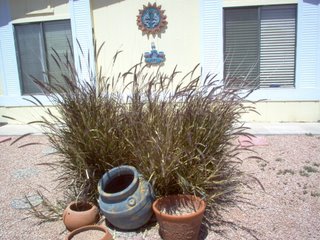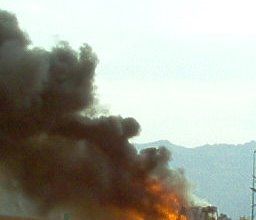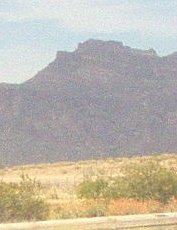Sonoran Spring

~SONORAN SPRING~
 I grew up in Michigan and was accustomed to the slow advance of a temperate spring, where it sidles ever so carefully closer, and then, one day, it is here! Blooms follw the same advance every year, snowdrops, hyacinths, and daffodils, then tulips and fruit trees, after that roses, berries and hardwoods, and finally the garden bursts in fecund glory; squash, cucumbers, tomatoes, peppers,and melons all bloom and mature almost magically. The hard green tomato of this morning will be deep red, tangy, and juicy in three days. But I digress, I wanted to share the Sonoran Spring with you.
I grew up in Michigan and was accustomed to the slow advance of a temperate spring, where it sidles ever so carefully closer, and then, one day, it is here! Blooms follw the same advance every year, snowdrops, hyacinths, and daffodils, then tulips and fruit trees, after that roses, berries and hardwoods, and finally the garden bursts in fecund glory; squash, cucumbers, tomatoes, peppers,and melons all bloom and mature almost magically. The hard green tomato of this morning will be deep red, tangy, and juicy in three days. But I digress, I wanted to share the Sonoran Spring with you. Here, in the middle of the Sonoran Desert; which extends from Western New Mexico to California, and from Nevada to Central Mexico; spring is sorrowfully brief. Spring is a few weeks in late April and early May, wedged between 'Snowbird Season' and Summer.
Here, in the middle of the Sonoran Desert; which extends from Western New Mexico to California, and from Nevada to Central Mexico; spring is sorrowfully brief. Spring is a few weeks in late April and early May, wedged between 'Snowbird Season' and Summer. When Spring does spring though, it is amazing and glorious.
When Spring does spring though, it is amazing and glorious. The varieties of cacti bloom with exuberant flowers in the shades of a desert sunset. Some cacti, like the Night-Blooming Cereus, bloom one night of the year, and the flower is dying by dawn.
 Saguaro (sa-Warr-oh) are staunchly upright, with a single column until they are over 50 years old, they are home to cactus wrens and doves, that nest on, or in, the Saguaro. A mature Saguaro can literally weigh tons. The inner part of this bristling giant is one enormous sponge, full of stored water against the long dry spells of the desert
Saguaro (sa-Warr-oh) are staunchly upright, with a single column until they are over 50 years old, they are home to cactus wrens and doves, that nest on, or in, the Saguaro. A mature Saguaro can literally weigh tons. The inner part of this bristling giant is one enormous sponge, full of stored water against the long dry spells of the desert The Cactus Wren pecks a hollow in the body of the Saguaro and builds a snug home for her babies, safe from almost all predators.
The Cactus Wren pecks a hollow in the body of the Saguaro and builds a snug home for her babies, safe from almost all predators. Doves will choose a 'cosy' cranny in the branches of a mature Saguaro, and build their nest there, surrounded by the cactus' natural armament. I have seen them return to the same nest every year.
Doves will choose a 'cosy' cranny in the branches of a mature Saguaro, and build their nest there, surrounded by the cactus' natural armament. I have seen them return to the same nest every year. Prickly Pear Cactus, AKA 'Irishman's Mitten' is edible, once you have burned the spines and skin off the plant or the fruit. The plant is pickled and marketed as 'Nopalitos' (NO pah-lee-tos), the fruit are made into jelly, just as one would turn grapes, apple, or berries into a jelly. I have not tried this, although I always stop to admire the crystal-clear red of the Prickly Pear Jelly, and candy!
Prickly Pear Cactus, AKA 'Irishman's Mitten' is edible, once you have burned the spines and skin off the plant or the fruit. The plant is pickled and marketed as 'Nopalitos' (NO pah-lee-tos), the fruit are made into jelly, just as one would turn grapes, apple, or berries into a jelly. I have not tried this, although I always stop to admire the crystal-clear red of the Prickly Pear Jelly, and candy! Agave (Ah-gah-vay) are not quite the same critter as cacti, but survive the dry seasons much the same way that cacti do. One of the Agave varieties is the basis for Tequila and Mezcal (Mess-cal), and yes, it really does have a 'pickled' grublike worm swirling in the bottom of the bottle!
Agave (Ah-gah-vay) are not quite the same critter as cacti, but survive the dry seasons much the same way that cacti do. One of the Agave varieties is the basis for Tequila and Mezcal (Mess-cal), and yes, it really does have a 'pickled' grublike worm swirling in the bottom of the bottle! While Aloe Vera is not native to the Sonoran Desert it thrives in the environment, the plant sends a tall, hollow shoot from the centre of the plant, which will be covered in numerous bright orange, yellow, or red trumpet blossoms peering intently at the ground.
While Aloe Vera is not native to the Sonoran Desert it thrives in the environment, the plant sends a tall, hollow shoot from the centre of the plant, which will be covered in numerous bright orange, yellow, or red trumpet blossoms peering intently at the ground. Organ Pipe cacti live up to their name, each plant is a mass of fat stems, shooting Heavenwards and a crown of blooms on their top. To see a valley with the Organ Pipe cacti marching in disorganised groups to the cliffs is an amazing sight, for they can reach almost 40 feet tall in adulthood.
Organ Pipe cacti live up to their name, each plant is a mass of fat stems, shooting Heavenwards and a crown of blooms on their top. To see a valley with the Organ Pipe cacti marching in disorganised groups to the cliffs is an amazing sight, for they can reach almost 40 feet tall in adulthood. Old Man Cactus are popular as a landscaping cactus, being smaller, and having the added feature of white 'hair' swirling through the rows of spines.
Old Man Cactus are popular as a landscaping cactus, being smaller, and having the added feature of white 'hair' swirling through the rows of spines.
The most commonly seen trees here are Palo Verde (Pal-oh Vurr-dee), Ironwood, Cottonwood, and Desert Willow. The Palo Verde are unmistakable with their light green leaves and bark.
Cottonwood scatter their 'cotton' far and wide, loose clumps of white threads holding one precious seed within.

The Desert Willow is best described as a 'short-haired' cousin to the Weeping Willow. The leaves on the Desert Willow are so small and leathery the plant often looks naked in the middle of spring.
The Ironwood Tree was very popular during World War II, my Grandmother told me years ago that it was used as a replacement for steel ball bearings in machines and equipment, and were found to be superior to the finest steel ball bearings. I trust my Grandmother's words on this, she worked in AC Spark Plug for year, as well as raising my Mum during those years.
 The 'Brain Cactus' looks very much like a brain in its early years, if it is planted outside it will grow long graceful arms that arc across the ground and eventually touch the ground again.
The 'Brain Cactus' looks very much like a brain in its early years, if it is planted outside it will grow long graceful arms that arc across the ground and eventually touch the ground again.No discussion of desert flora could be complete without the ubiquitous Cholla (Choy-yah), also known as the 'jumping cactus', from their method of propagation; when a person or animal walks too close to the living Cholla plant, pieces of the plant break off and hitch a ride using the barbed spines, thick as an ermine's coat, that give the cholla a fuzzy, huggable appearance.
 Cacti will die, everything does. When the cacti fall over and begin returning to the earth as they ought, they leave behind amazing skeletons. The skeletons are as diverse as the cacti themselves. Saguro have long, straight ribs that are strong enough to be used as a walking stick or in a piece of furniture.
Cacti will die, everything does. When the cacti fall over and begin returning to the earth as they ought, they leave behind amazing skeletons. The skeletons are as diverse as the cacti themselves. Saguro have long, straight ribs that are strong enough to be used as a walking stick or in a piece of furniture.Because they are so popular for the 'desert landscaping' adopted here they are almost impossible to find in the desert, and when you do see them, they are on protected land and so are to be left there.
 Cholla skeletons are hollow, fragile and honeycombed with holes.
Cholla skeletons are hollow, fragile and honeycombed with holes.
The desert also has short, fat sagebrush plants dotting the flatlands and foothills, and yes, there really are tumbleweeds! They grow, rooted in one place, until the seeds begin to mature, the plant dies and dries as the seed ripens. When the seed is ready, the plant is brittle and dry and a good wind will break it off at the base. As it scurries mindlessly about the landscape the tumbleweed scatters seed as it goes, the seed slips into crevices in the hardpan, or tiny patches of soil. Next rainy season the cycle begins anew.
 Citrus bloom with dainty white, star-shaped petals that permeate the air with perfume. Although I am severely allergic to citrus, I still fill my nose with the scent of freshly watered citrus groves. The citrus are lookalike until they are reaching full size, all of them are a deep green, with that instantly recognisable thick, pockmared skin.
Citrus bloom with dainty white, star-shaped petals that permeate the air with perfume. Although I am severely allergic to citrus, I still fill my nose with the scent of freshly watered citrus groves. The citrus are lookalike until they are reaching full size, all of them are a deep green, with that instantly recognisable thick, pockmared skin.











